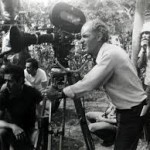TOMÁS “Titón” GUTIÉRREZ ALEA, FILMMAKER.
Tomás Gutiérrez Alea was born in Havana on December 11, 1928 was a Cuban filmmaker. He wrote and directed more than 20 features, documentaries, and short films, which are known for his sharp insight into post-Revolutionary Cuba, and possess a delicate balance between dedication to the revolution and criticism of the social, economic, and political conditions of the country.
Gutiérrez was raised in an affluent, politically progressive family. Alea was sent to college in Havana to follow in his father’s footsteps and become a lawyer. At about the same time he entered school, though, he acquired an 8mm and made two short films, El faquir (1947) and La caperucita roja (1947). Several years later, he collaborated with fellow student (and future film great) ‘Nestor Almendros’ on a short Kafka adaptation they named Una confusión cotidiana (1950). Upon graduation, Alea journeyed to Italy to study film directing for two years during the crest of neorealism at the famed Centro Sperimentale de Cinematografia. He was heavily influenced by Italian Neorealism, and created his first films in Rome with future Cuban colleague Julio García Espinosa, with whom he co-directed the documentary film El Mégano (The Charcoal Worker). He returned to Cuba in 1953 and joined the radical “Nuestro Tiempo” cultural society, becoming active in the film section, working as a publicist and aligning himself with Castro’s fight against the Batista regime.in 1953.
Gutiérrez’s work is representative of a cinematic movement occurring in the 1960s and 1970s known collectively as the New Latin American Cinema. This collective movement, also referred to by various writers by specific names such as “Third Cinema”, “Cine Libre”, and “Imperfect Cinema,” was concerned largely with the problems of neocolonialism and cultural identity. The movement rejected both the commercial perfection of the Hollywood style, and the auteur-oriented European art cinema, for a cinema created as a tool for political and social change. Due not in a small part to the filmmakers’ lack of resources, aesthetic was of secondary importance to cinema’s social function. The movement’s main goal was to create films in which the viewer became an active, self-aware participant in the discourse of the film. Viewers were presented with an analysis of a current problem within society that as of that time had no clear solution, hoping to make the audience aware of the problem and to leave the theater willing to become actors of social change.
https://youtu.be/RxECJaMjnLw
Shortly after the success of the Cuban Revolution led by Fidel Castro in 1959, Gutiérrez, Espinosa, and several other young filmmakers founded the Instituto Cubano del Arte y la Industria Cinematográphicos (ICAIC). As ardent supporters of the Revolution, ICAIC was a filmmaker’s collective which believed film to be the most important modern art form and the best medium to distribute revolutionary thought to the masses. Gutiérrez’s Esta Tierra Nuestra (This Land Of Ours), was the first documentary made after the revolutionary victory. ICAIC focused mostly on documentaries and newsreels in its formative years, but eventually expanded into production of feature films, including Gutiérrez’s early Historias de la Revolución (Stories Of The Revolution) (1960), ICAIC’s first fiction film, and Doce sillas (Twelve Chairs), (1962).
Although criticism of the Revolution and Cuban society was at the heart of not only Memories, but all of Gutiérrez’s works, Gutiérrez continued to be a dedicated supporter of Cuban Socialism. But his works could hardly be described as propaganda either. Gutiérrez described the motivation for his contradictory approach by saying: “…cinema provides an active and mobilizing element, which stimulates participation in the revolutionary process. Then, it is not sufficient to have a moralizing cinema based on harangue and exhortation. We need a cinema that promotes and develops a critical attitude. But how to criticize and at the same time strengthen the reality in which we are immersed?”
In the early 1990s, Gutiérrez fell into ill health, forcing him to co-direct his last two films with his friend Juan Carlos Tabío. Gutiérrez’s final film, Guantanamera, (1994) uses traditional elements such as an ensemble cast and romantic comedy to take a more subtle approach to Gutiérrez’s old targets: underdevelopment and bureaucracy. The film won the Silver Jury Prize at the 44th Berlin International Film Festival.
Titón, as he was known to his friends, died at age 68 on April 16, 1996. He is buried in the Colon Cemetery, Havana.
Wiki/CubanMov./InternetPhotos/YouTube/TheCubanHistory.com
The Cuban History, Hollywood.
Arnoldo Varona, Editor.
TOMÁS “Titón” GUTIÉRREZ ALEA, CINEASTA.
Tomás Gutiérrez Alea nació en La Habana el 11 de diciembre 1928 fue un director de cine cubano. Escribió y dirigió más de 20 funciones, documentales y cortometrajes, que son conocidos por su visión aguda en Cuba post-revolucionaria, y poseer un delicado equilibrio entre la dedicación a la revolución y la crítica de las condiciones sociales, económicas y políticas del país.
Gutiérrez fue criado en una familia acomodada, políticamente progresista. Alea fue enviado a la Universidad de La Habana para seguir los pasos de su padre y convertirse en un abogado. Casi al mismo tiempo que él entró en la escuela, sin embargo, él adquirió un 8 mm y realizó dos cortometrajes, El faquir (1947) y La caperucita roja (1947). Varios años más tarde, colaboró con su compañero de estudios (y futura película genial) Nestor Almendros ‘en un corto adaptación Kafka llamaron Una confusión cotidiana (1950). Después de su graduación, Alea viajó a Italia para estudiar dirección de cine durante dos años en la cresta del neorrealismo en el famoso Centro Sperimentale de Cinematografia. Él fue fuertemente influenciado por neorrealismo italiano, y creó sus primeras películas en Roma con futuro colega cubano Julio García Espinosa, con quien co-dirigió la película documental El Mégano (El Trabajador del carbón de leña). Regresó a Cuba en 1953 y se unió a la sociedad cultural radical “Nuestro Tiempo”, llegando a ser activo en la sección de cine, trabajando como publicista y alineándose con la lucha de Castro contra Batista regime.in 1953.
La obra de Gutiérrez es representante de un movimiento cinematográfico se produce en los años 1960 y 1970 conocidas colectivamente como el Nuevo Cine Latinoamericano. Este movimiento colectivo, también conocida por varios escritores por nombres específicos como “tercer cine”, “Cine Libre”, y “Imperfect Cine”, se refiere en gran medida los problemas de neocolonialismo y la identidad cultural. El movimiento rechazó tanto la perfección comercial del estilo de Hollywood y el cine europeo de autor arte orientadas, por un cine creado como una herramienta para el cambio político y social. Debido no en una pequeña parte a la falta de recursos de los realizadores, estética era de importancia secundaria a la función social del cine. El principal objetivo del movimiento era crear películas en las que el espectador se convirtió en una, participante activo consciente de sí mismo en el discurso de la película. Los espectadores se presentaron con un análisis de un problema actual en la sociedad que a partir de ese momento no tenía ninguna solución clara, con la esperanza de hacer que el público consciente del problema y dejar el teatro dispuesto a convertirse en actores del cambio social.
https://youtu.be/RxECJaMjnLw
Poco después del éxito de la Revolución Cubana liderada por Fidel Castro en 1959, Gutiérrez, Espinosa, y varios otros jóvenes cineastas fundaron el Instituto Cubano del Arte y la Industria Cinematográphicos (ICAIC). Como ardientes defensores de la Revolución, el ICAIC era colectiva de un cineasta que cree película sea la forma de arte moderno más importante y el mejor medio para distribuir el pensamiento revolucionario de las masas. Esta tierra nuestra de Gutiérrez (Esta tierra nuestra), fue el primer documental realizado después de la victoria revolucionaria. ICAIC centró principalmente en documentales y noticiarios en sus años de formación, pero con el tiempo se expandió a la producción de largometrajes, incluidos los principios de Historias de Gutiérrez de la Revolución (Historias de la Revolución) (1960), primera película de ficción del ICAIC, y sillas Doce (Doce Sillas) , (1962).
Aunque la crítica de la Revolución y la sociedad cubana estaba en el corazón de no sólo los recuerdos, pero todas las obras de Gutiérrez, Gutiérrez continuó siendo un ávido partidario del socialismo cubano. Pero sus obras no podrían ser descritos como propaganda tampoco. Gutiérrez describió la motivación por su enfoque contradictoria diciendo: “… el cine ofrece un elemento activo y movilizador, que estimula la participación en el proceso revolucionario. Entonces, no es suficiente tener un cine moralizante basado en arenga y exhortación. Necesitamos un cine que promueve y desarrolla una actitud crítica. Pero, ¿cómo criticar y al mismo tiempo fortalecer la realidad en la que estamos inmersos? ”
A principios de 1990, Gutiérrez cayó en mala salud, lo que le obligó a co-dirigir sus últimas dos películas con su amigo Juan Carlos Tabío. La película de Gutiérrez final, Guantanamera, (1994) utiliza elementos tradicionales como un reparto coral y comedia romántica que adoptar un enfoque más sutil a los objetivos antiguos de Gutiérrez: el subdesarrollo y la burocracia. La película ganó el Premio de Plata del Jurado en el 44º Festival Internacional de Cine de Berlín.
Titón, como lo conocían sus amigos, murió a los 68 años el 16 de abril de 1996. Está enterrado en el Cementerio de Colón, La Habana.
Wiki / CubanMov. / InternetPhotos / YouTube / TheCubanHistory.com
La Historia de Cuba, de Hollywood.
Arnoldo Varona, Editor.






